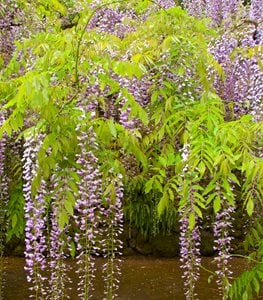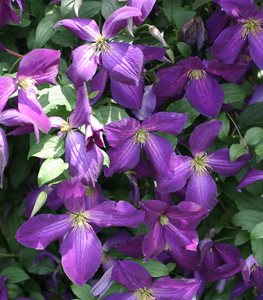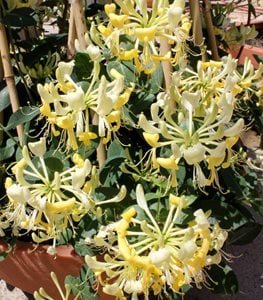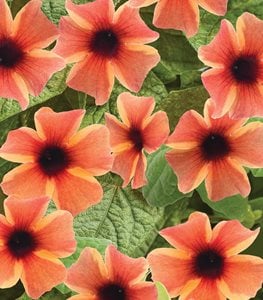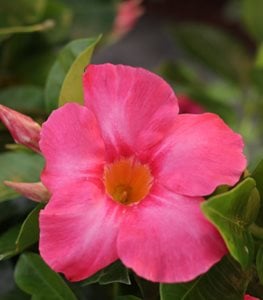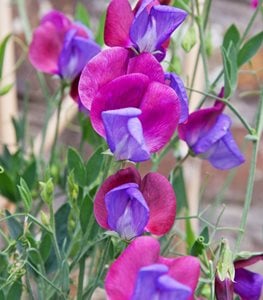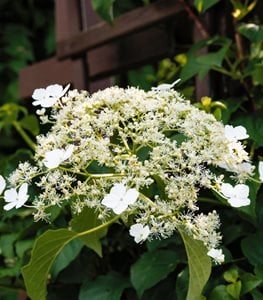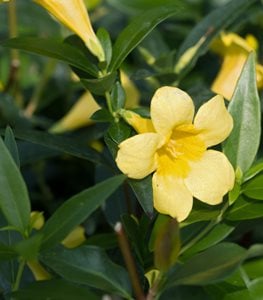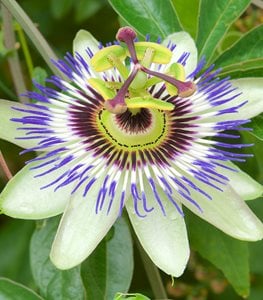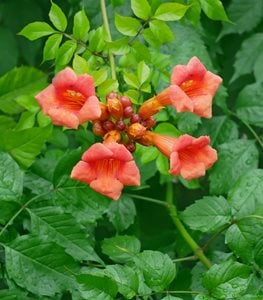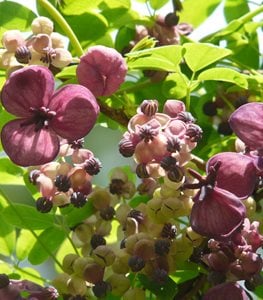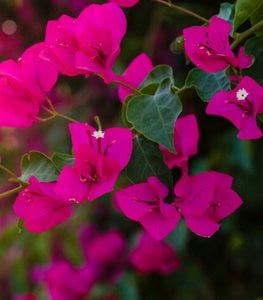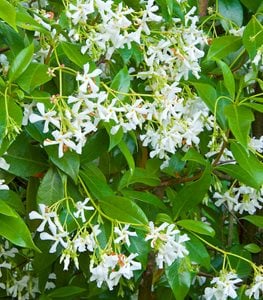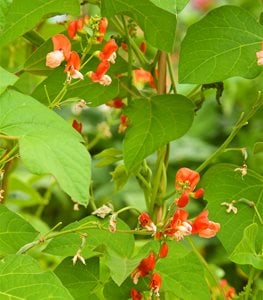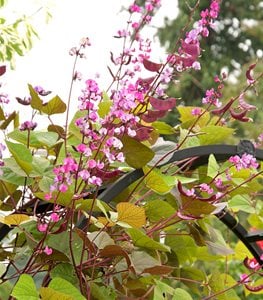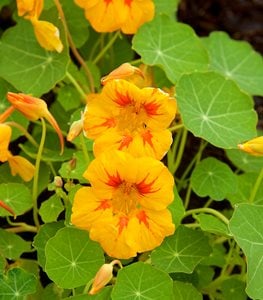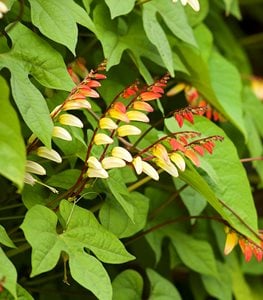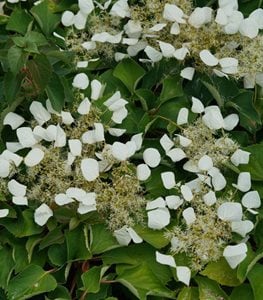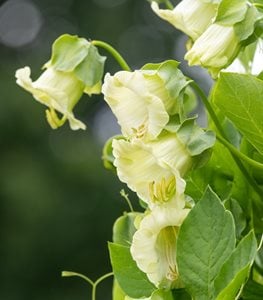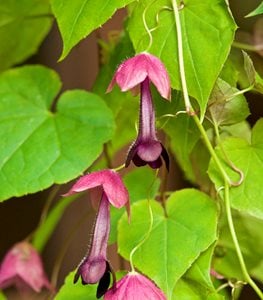The Best Flowering Vines for Your Garden
Add a new dimension to your landscape with vertical vinesThe easiest way to increase your gardening space is to add ornamental plants that grow vertically. Flowering vines come in an array of sizes and colors, with both annual and perennial types. Many bloom for weeks or months for continuous color.
Vines can be grown up a trellis, arbor, pergola, fence, or wall depending on their method of attachment (see more below). Smaller forms are suitable for trailing in hanging baskets, window boxes, and containers.
Many vines grow rapidly and some species aren't appropriate for all areas. Check local resources to make sure you are choosing a vine that's right for your garden.
Why are many vining plants considered aggressive or invasive? Some of the vining invasives are that way because of their vining, sprawling habit, but they often also have seeding tendencies which can be most of the problem. And they displace natives that are not as competitive. For instance, honeysuckle grows aggressively, but they are invasive mostly because birds love their seeds and disperse them where they can outcompete natives. (See more on invasive vs. aggressive plants below.)
On this page: Flowering Vines | How Vines Attach Themselves | Invasive vs. Aggressive Vines
On this page:
21 FLOWERING VINES
WISTERIA (Wisteria spp.)
Zones: 5-9
Exposure: Full sun to partial shade
Height/Spread: 10 to 50 feet long, 4 to 30 feet wide
Method of attachment: Tendrils
One of the best-known climbing flowering vines, grown for its long hanging clusters of pea-like flowers in shades of lavender, purple, white, or blue. The most commonly grown are Japanese (W. floribunda), Chinese (W. sinensis) and American wisteria (W. frutescens), which bloom in spring or summer. This vigorous perennial vine needs strong support and judicious pruning, and can be damaging to homes or structures if not kept in check.
NOTE: Wisteria is invasive* in some regions, so check with your local garden center or extension service before planting. American wisteria is less invasive and aggressive than Asian types.
Learn more about growing wisteria.
CLEMATIS (Clematis spp.)
Zones: 3-10
Exposure: Full sun to partial shade
Height/Spread: 2 to 50 feet tall, 2 to 10 feet wide
Method of attachment: Petiole tendrils
One of the most versatile perennial flowering vines, clematis can be grown in most regions, with flowers in a range of colors and shapes. This reliable vine can bloom from early spring to fall, depending on the type, with many varieties producing attractive seed heads. Most are deciduous, while Armand’s clematis (C. armandii) is evergreen. Grow along a building, trellis or arbor, either in the ground or containers.
Learn more about growing clematis.
Happy Jack® Purple clematis from Proven Winners, pictured.
HONEYSUCKLE (Lonicera spp.)
Zones: 4-10
Exposure: Full sun to partial shade
Height/Spread: 8 to 30 feet tall, 3 to 30 feet wide
Method of attachment: Tendrils
Honeysuckle is usually grown for its intensely fragrant tubular flowers that attract hummingbirds, butterflies, and other insect pollinators; although some varieties have no scent. Flowers can be yellow, orange, red, white, or bicolored. This vigorous perennial vine is deciduous, semi-evergreen, or evergreen, blooming from spring to fall depending on the variety. Use to cover a pergola, arbor or trellis that is large enough to support its weight.
NOTE: Some varieties are aggressive and invasive* in certain areas.
Learn more about growing honeysuckle.
'Scentsation' honeysuckle from Proven Winners, pictured, is a non-invasive variety.
BLACK-EYED SUSAN VINE (Thunbergia alata)
Zones: 10-11, or grown as an annual
Exposure: Full sun to partial shade
Height/Spread: 3 to 8 feet tall, 1-1/2 to 6 feet wide
Method of attachment: Twining stems
Cheerful five-petaled flowers come in shades of yellow, orange, apricot, coral, white, or bicolor, with an eye-catching dark center. This fast growing annual or tender perennial vine produces attractive heart-shaped leaves, blooming continuously from summer into fall. Use as screening on a trellis, fence or arbor. Makes a stunning stand-alone accent in a hanging basket or combined with other annuals in window boxes and containers.
Learn more about growing black-eyed Susan vines.
Tangerine Slice A-Peel® black-eyed Susan vine from Proven Winners, pictured.
MANDEVILLA (Mandevilla spp.)
Zones: 9-11, or grown as an annual
Exposure: Full sun to partial shade
Height/Spread: 3 to 15 feet tall, 3 to 6 feet wide
Method of attachment: Twining stems
Exotic trumpet-shaped flowers of this annual or tender perennial occur in colors of red, pink, white, or apricot. Plants bloom continuously from summer through fall, or year-round in warmer climates. Grow this fast-growing vine in containers or hanging baskets, or allow to clamor up a trellis. Place on a patio, deck, porch, or in a courtyard to enjoy the blooms up close.
Learn more about growing mandevilla.
Bombshell™ Coral Pink mandevilla hybrid from Proven Winners, pictured.
SWEET PEA (Lathyrus odoratus)
Zones: Grown as an annual
Exposure: Full sun to partial shade
Height/Spread: 4 to 8 feet tall, 2 to 3 feet wide
Method of attachment: Tendrils
This old-fashioned favorite is revered for its pea-like blooms that come in an array of colors including pink, red, purple, lavender, blue, orange, yellow, apricot, white, and bicolors. This cottage garden staple prefers cooler conditions, blooming in late winter to early spring in warm climates and from late spring to fall in cooler regions. Grow up a trellis and place where the sweet fragrance can be enjoyed. Makes an excellent cut flower.
CLIMBING HYDRANGEA (Hydrangea anomala subsp. petiolaris)
Zones: 4-9
Exposure: Full sun to shade
Height/Spread: 30 to 50 feet tall, 5 to 6 feet wide
Method of attachment: Aerial rootlets
Though hydrangea is one of the most beloved landscape shrubs, its climbing counterpart is lesser known. Climbing hydrangea is a flowering vine for shade, suitable for woodland gardens. Delicate panicled white flowers bloom from late spring to mid-summer. This robust deciduous vine needs plenty of room and sturdy support, and is often trained up a large tree such as a mature fir or oak. In smaller spaces, grow on a wall or sturdy arbor and keep well pruned.
CAROLINA JESSAMINE (Gelsemium sempervirens)
Zones: 7-10
Exposure: Full sun to partial shade
Height/Spread: 10 to 20 feet tall, 3 to 6 feet wide
Method of attachment: Twining stems
Native to parts of the southern U.S., Carolina jessamine flowers from late winter to early spring before many other plants are in bloom. Also known as Carolina yellow jasmine, this evergreen or semi-evergreen vine produces prolific clusters of golden yellow trumpet-shaped flowers that are sweetly scented. Can be grown up a sturdy arbor or pergola, or allowed to sprawl as a groundcover. Use as a privacy screen or to hide an unsightly feature such as a chainlink fence.
MORNING GLORY (Ipomoea spp.)
Zones: Grown as an annual
Exposure: Full sun
Height/Spread: 4 to 15 feet tall, 2 to 6 feet wide
Method of attachment: Tendrils
This fast-growing flowering vine is a popular mainstay in cottage-style gardens. Large heart-shaped leaves provide an attractive backdrop to funnel-shaped flowers in shades of purple, blue, pink, white, and bicolor patterns. Plants bloom from early summer to frost, with each single flower lasting just one day. Use this annual as screening on a trellis or arbor, or grow along a wall or fence. Easy to grow from seed.
NOTE: Although not to be confused with bindweed (Convulvulous arvensis), some ornamental morning glories can self-sow readily and have also been determined to be aggressive or invasive* in certain areas.
Learn more about growing morning glory vines.
PASSIONFLOWER (Passiflora spp.)
Zones: 5-11
Exposure: Full sun to partial shade
Height/Spread: 6 to 30 feet tall, 3 to 6 feet wide
Method of attachment: Twining stems
Add tropical flair to borders and containers with passionflower. The exotic blooms are multi-layered, with a base of rounded petals topped by a collar of thin radiating filaments, and a vertical antennae-like center. Flowers, which bloom from summer into fall, are purple, blue, red pink, green, white, or multi-colored. Use this vigorous quick-growing vine as a screen, to cover a fence or arbor.
NOTE: Can be invasive* in warmer regions.
Learn more about growing passionflower vines.
TRUMPET VINE (Campsis radicans)
Zones: 4-9
Exposure: Full sun to partial shade
Height/Spread: 20 to 40 feet tall, 5 to 10 feet wide
Method of attachment: Aerial roots
Trumpet vine, also known as trumpet creeper, is one of the best flowering vine plants to attract hummingbirds and butterflies. Lush serrated foliage provides an attractive backdrop to clusters of large funnel-shaped flowers in colors of red, orange, or yellow that appear in summer. Use this deciduous vine as screening on an arbor or pergola large enough support its weight.
NOTE: This fast-growing vine can be invasive* in warmer regions, spreading by seed and underground runners.
CHOCOLATE VINE (Akebia quinata)
Zones: 4-8
Exposure: Full sun to partial shade
Height/Spread: 20 to 40 feet tall, 6 to 9 feet wide
Method of attachment: Twining stems
Also known as five-leaf akebia, this deciduous woody vine is named for the dangling clusters of deep purple flowers and chocolate fragrance. The flowers, which appear from early to mid-spring, are followed by violet sausage-shaped seed pods. This vigorous grower needs strong support and judicious pruning to keep it in check. Foliage is semi-evergreen in warmer climates. Use as screening or to cover an arbor or pergola, or plant as a groundcover along a slope for erosion control.
NOTE: Chocolate vine is considered invasive* in some regions.
BOUGAINVILLEA (Bougainvillea spp.)
Zones: 9-12
Exposure: Full sun
Height/Spread: 2 to 30 feet tall and wide
Method of attachment: Twining stems
This tropical vine is a popular choice in frost-free regions for its prolific bloom and carefree nature. Plants bloom nearly year-round, with clusters of flowers in bright hues of pink, orange, coral, red, yellow, orange, and occasionally white. This vigorous woody vine needs strong support and regular pruning to keep it in check. Grow along a wall, arbor, or pergola, or use as a low-maintenance groundcover. In cooler climates, smaller specimens can be grown in a hanging basket or container and overwintered indoors.
Learn more about growing bougainvillea.
STAR JASMINE (Trachelospermum jasminoides)
Zones: 8-10
Exposure: Full sun to partial shade
Height/Spread: 3 to 20 feet tall, 3 to 6 feet wide
Method of attachment: Twining stems
Star jasmine is grown for its intensely fragrant clusters of white star-shaped flowers and attractive glossy evergreen leaves. Plants can bloom for up to several months from late spring through late summer. Grow on a sturdy arbor, pergola, fence, or wall that is strong enough to support its weight. Can also be used as a formal groundcover in a courtyard or curbside strip, or along a slope. Espalier or keep neatly trimmed for a formal look.
Learn more about growing star jasmine.
SCARLET RUNNER BEAN (Phaseolus coccineus)
Zones: 7-11, primarily grown as an annual
Exposure: Full sun to partial shade
Height/Spread: 8 to 12 feet tall, 3 to 5 feet wide
Method of attachment: Twining stems
This quick-growing annual or tender perennial vine, related to green beans, has a similar growth habit to pole beans. A staple of early American food gardens, this heirloom is now grown primarily for the ornamental pea-like flowers in shades of scarlet, pink, white, or bicolors. Flowers are attractive to hummingbirds and bees. Easily grown from seed, train on a teepee, arbor, trellis or fence. Both the pods and beans are edible.
HYACINTH BEAN (Lablab purpureus)
Zones: 10-11, primarily grown as an annual
Exposure: Full sun to partial shade
Height/Spread: 10 to 20 feet tall, 3 to 6 feet wide
Method of attachment: Twining stems
Hyacinth bean is grown for its ornamental attributes of purple-tinged heart-shaped leaves, red stems, and pea-like blooms. The bright burgundy pods are edible, along with the shelled beans. The fragrant flowers, attractive to hummingbirds and insect pollinators, occur in shades of rose-purple, pink, or white. Provide a strong structure to support the weight of this quick growing vine. Use as screening, on arbors, fencing, or pergolas.
NASTURTIUM (Tropaeloum majus)
Zones: Usually grown as an annual
Exposure: Full sun
Height/Spread: 1 to 10 feet tall, 1 to 3 feet wide
Method of attachment: Twining petiole tendrils
A staple of kitchen and cottage-style gardens, nasturtium is grown for its rounded foliage and endearing tubular flowers. Blooms, which appear from late spring to fall, occur in a range of rich jewel-like colors, including orange, red, yellow, apricot, pink, purple, cream, and patterned bicolors. Foliage can be green or variegated. Use this carefree annual to edge kitchen plots, allow to spill over rock walls, plant in a hanging basket, or grow up a small trellis. The leaves and flowers are edible.
FIRECRACKER VINE (Ipomoea lobata)
Zones: 9-11, or grown as an annual
Exposure: Full sun
Height/Spread: 10 to 15 feet tall, 1 to 2 feet wide
Method of attachment: Twining stems
This tender perennial is named for the showy flowers that are reminiscent of fireworks. Also known as Spanish flag, the vertical 6-inch stalks of tubular flowers are brilliant orange at the top, graduating to yellow, then creamy white at the bottom for an eye-catching multi-colored effect. The flowers, which bloom continually from mid-summer until frost, are highly attractive to hummingbirds, butterflies, and insect pollinators. Use this quick grower as screening, train up an arbor or trellis, or along a fence.
FALSE HYDRANGEA VINE (Schizophragma hydrangeoides)
Zones: 5-8
Exposure: Partial sun to full shade
Height/Spread: 20 to 50 feet tall, 6 to 10 feet wide
Method of attachment: Aerial rootlets
The flowers of this hydrangea look-alike are similar to those of climbing hydrangea, but bloom later in the season. Delicate flat-topped flower panicles 8 to 10 inches across bloom in mid-summer in shades of white or creamy white. The deciduous foliage turns yellow in fall, with reddish-brown stems and peeling bark offering winter interest. Grow this shade-tolerant woody perennial vine in a woodland setting, training up a mature tree or other structure sturdy enough to hold its weight.
Flirty Girl™ false hydrangea vine from Proven Winners, pictured.
CUP & SAUCER VINE (Cobaea scandens)
Zones: 9-11, or grown as an annual
Exposure: Full sun
Height/Spread: 10 to 20 feet tall, 3 to 6 feet wide
Method of attachment: Tendrils
Native to Mexico and South America, this tender perennial is most often grown as an annual. Large showy cup or bell-shaped flowers are framed by saucer-like green petals, hence its common name. Blooming from summer into fall, the honey-scented flowers start out pale green, turning white or purple as they mature. Grow along a fence or on a sturdy trellis or arbor that is strong enough to support its weight.
PURPLE BELL VINE (Rhodochiton atrosanguineus)
Zones: 9-11, or grown as an annual
Exposure: Full sun to partial shade
Height/Spread: 6 to 10 feet tall, 1 to 2 feet wide
Method of attachment: Twining stems
Purple bell vine is a tender perennial grown as an annual. This fast grower produces serrated heart-shaped leaves and exotic bell-shaped purple flowers. Blooms from summer until frost. Grow this smaller vine up a trellis or allow to cascade in a hanging basket. Display on a porch, patio or deck where the dangling flowers can be appreciated up close.
HOW VINES ATTACH THEMSELVES
Understanding how different vines and climbing plants attach themselves will help you pick an appropriate support structure for your climber.
- Twining stems: As vines grow they wrap their stems around the supporting structure, such as poles, chain-link fences, trellises, or arbors.
- Tendrils or petioles: Thin, flexible leafless stems (tendrils) or the short stems that attach the leaf to the stem (petioles) wrap around narrow supports such as thin poles, stakes, wire, twine, or chain-link fencing.
- Aerial roots: Small root-like structures growing out of the sides of the stems attach the plant to rough-textured surfaces such as the textured bark of trees or masonry.
- Hold fasts: Disk-like adhesive pads on plants such as Boston ivy or Virginia creeper attach to almost any smooth surface.
(Resource: Vines: Climbers & Twiners: Methods of Attachment, University of Illinois Extension)
*INVASIVE VS. AGGRESSIVE GROWERS
When learning about plants, it's important to understand what it means for a plant to be invasive. From the USDA website: "An invasive species is non-native to the ecosystem under consideration, and whose introduction causes or is likely to cause economic or environmental harm or harm to human health."
Keep in mind that a plant may be invasive in one environment, but okay to grow in another. So, although some of the plants above are noted as being invasive in certain regions, they are fine to grow in others.
It's also important to note that there is a difference between a plant being considered invasive and one that grows aggressively. The Universiy of Illinios Extension Service defines aggressive plants as those that have the ability to "spread fast enough within the garden as to cause issues to other garden areas where the plant is not wanted or is intended to be growing." This is not the same as being identified as being invasive.
Resources for determining if a vine or plant is invasive in your region:
- Your local extension service (search online)
- Local Master Gardener's Association (search online)
- Invasive Plant Atlas
More: Invasive Plants & What to Grow Instead
Featured in: Garden Design's Top 10 Garden Trends for 2022 ("Blurring the Lines Between Indoors & Out")
RELATED:
10 Late-Blooming Flowers
21 Fall Container Ideas
Fall Gardening Tips & Chores

